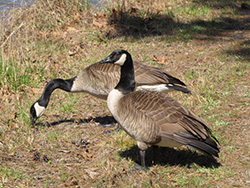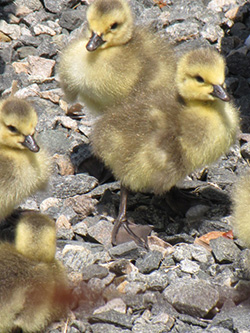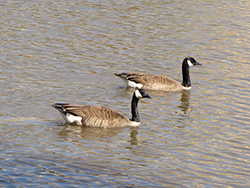A Canada Goose Story
By Bill Willis
May, 2016

The Canada Goose (Branta canadensis), with its black head and neck, and characteristic white “chinstrap,” is a magnificent bird and a longtime mainstay of local grounds. Encountering a gaggle of geese and their goslings serves as a relaxing backdrop to the already park-like setting of the NIEHS campus.
Coexisting with these feathered friends, however, is not without its challenges.
The Research Triangle region of North Carolina hosts one of the largest permanent (non-migratory) populations of Canada Geese in the nation — the NIEHS campus in particular as it’s an ideal habitat for the species. This has led to an increased population of both migratory and permanent populations, in addition to rising employee concerns over excessive walkway droppings, aggressive bird behavior, and the not-so-occasional traffic encounter.

Various approaches have been used to control the onsite goose population in an acceptable and effective manner. In the past, these have included strategic landscape plantings and permitted nest management techniques, but such measures are no longer used, as geese numbers have decreased.
Beyond the NIEHS campus, Canada Geese are protected under the Migratory Bird Treaty Act. This makes interfering with birds and nesting activities subject to restrictions outside of hunting season.
Check all the other types of birds you might find on the EPA/NIEHS RTP Campus:
- Acadian Flycatcher
- American Black Duck
- American Coot
- American Crow
- American Goldfinch
- American Kestrel
- American Redstart
- American Robin
- American Wigeon
- Bald Eagle
- Barn Swallow
- Baltimore Oriole
- Belted Kingfisher
- Black Duck
- Black Vulture
- Black-and-white
- Black-throated Blue
- Blackburnian Warbler
- Blue Grosbeak
- Blue Jay
- Blue-gray Gnatcatcher
- Blue-winged Teal
- Bonaparte's Gull
- Broad-winged Hawk
- Brown Thrasher
- Brown-headed
- Bufflehead
- Canada Goose
- Canvasback
- Carolina Chickadee
- Carolina Wren
- Cedar Waxwing
- Chimney Swift
- Chipping Sparrow
- Common Grackle
- Common Loon
- Common Yellowthroat
- Cooper's Hawk
- Dark-eyed Junco
- Double-crested
- Down Woodpecker
- Eastern Bluebird
- Eastern Kingbird
- Eastern Phoebe
- Eastern Towhee
- European Starling
- Field Sparrow
- Fish Crow
- Fox Sparrow
- Golden-crowned
- Gray Catbird
- Great Blue Heron
- Great Crested
- Great Egret
- Greater Scaup
- Green Heron
- Green-winged Teal
- Hairy Woodpecker
- Hermit Thrush
- Hooded Merganser
- Hooded Warbler
- Horned Grebe
- House Finch
- House Sparrow
- Indigo Bunting
- Killdeer
- Least Flycatcher
- Lesser Scaup
- Louisiana
- Magnolia Warbler
- Mallard
- Merlin
- Mourning Dove
- Northern Cardinal
- Northern Flicker
- Northern Mockingbird
- Northern Parula
- Northern Rough
- Northern Shoveler
- Northern Waterthrush
- Orchard Oriole
- Osprey
- Ovenbird
- Palm Warbler
- Pied-billed Grebe
- Pileated Woodpecker
- Pine Siskin
- Pine Warbler
- Purple Martin
- Red-bellied
- Red-breasted Nuthatch
- Red-eyed Vireo
- Red-headed
- Red-shouldered Hawk
- Red-tailed Hawk
- Red-throated Loon
- Red-winged Blackbird
- Redhead
- Ring-billed Gull
- Ring-necked Duck
- Rock Pigeon
- Ruby-crowned Kinglet
- Ruby-throated
- Ruddy Duck
- Scarlet Tanager
- Sharp-shinned Hawk
- Solitary Sandpiper
- Song Sparrow
- Spotted Sandpiper
- Summer Tanager
- Tree Swallow
- Tufted Titmouse
- Turkey Vulture
- Veery
- White-breasted
- White-throated
- Wood Duck
- Wild Turkey
- Yellow-bellied
- Yellow-breasted Chat
- Yellow-rumped
- Yellow-throated Vireo
- Yellow Warbler
Looking Forward
The campus Wildlife and Industry Together (WAIT) program will soon begin monitoring area geese to better understand the size of their breeding population, as well as the effect migratory birds are having on total bird counts. From last fall to this spring, geese numbers fluctuated from a low of 6 to a high of 120 as migrating birds stopped to feed on their flights elsewhere.

WAIT is also coordinating with the Comparative Medicine Branch to monitor North Carolina Department of Agriculture and U.S. Center for Disease Control communications on avian flu in the Tar Heel state.
(Bill Willis is a biologist with the NIEHS Reproductive and Developmental Biology Laboratory, and a regular contributor to the Grapevine.)



